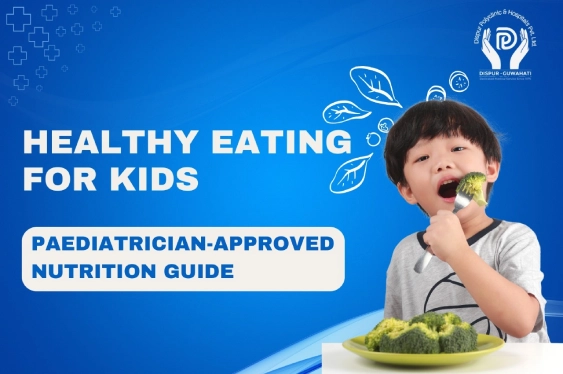- January 24, 2025
- Editorial Team
- Comment: 0
- Blog
Healthy Eating for Kids: Paediatrician-Approved Nutrition Guide
Healthy eating for kids isn’t just about fuelling little bodies; it’s about laying the foundation for lifelong wellness.
As parents, we often wonder if we’re providing the right nutrients to help our children grow, learn, and thrive. With so much information (and misinformation) out there, it’s easy to feel overwhelmed.
That’s why we’ve created this paediatrician-approved nutrition guide to make healthy eating for kids simple, actionable, and stress-free.
In this blog, we’ll cover everything from the essential food groups to practical meal ideas, ensuring your child receives the nutrition they need to shine.
Why is Healthy Eating for Kids Important?
Ensuring a balanced diet during childhood is vital because it:
Promotes Growth and Development: Nutrients like calcium and protein play a crucial role in building strong bones and muscles.
Boosts Immunity: Vitamins and minerals such as Vitamin C, iron, and zinc help protect kids from illnesses.
Improves Concentration and Learning: A nutritious diet fuels the brain, leading to better focus and academic performance.
Builds Healthy Habits for Life: Kids who learn to enjoy wholesome foods early are more likely to make better choices as adults.
Healthy Eating for Kids: The Building Blocks of a Balanced Diet
Essential Food Groups for Kids
A healthy plate should include:
Fruits and Vegetables: Aim for colourful varieties, as they provide essential vitamins, minerals, and fibre.
Whole Grains: Swap refined options for whole grains like brown rice, whole wheat bread, and oats.
Protein: Incorporate lean meats, eggs, beans, lentils, nuts, and seeds to ensure muscle development.
Dairy or Dairy Alternatives: Rich in calcium and Vitamin D, they are critical for bone health.
Healthy Fats: Include sources like avocados, nuts, seeds, and olive oil for brain development.
Portion Sizes Made Simple
Portion sizes for kids depend on age, activity level, and appetite.
A handy guide:
Preschoolers (2-5 years): Smaller portions with frequent snacks.
Primary Schoolers (6-12 years): Balanced meals and two healthy snacks.
Teenagers: Increased portion sizes with an emphasis on nutrient-dense options.
Healthy Eating for Kids: Overcoming Common Challenges
Picky Eaters
If your child is a picky eater, try these tricks:
Make it Fun: Create “rainbow plates” with colourful fruits and veggies.
Get Them Involved: Let kids help with meal prep – they’ll be excited to eat what they made.
Be a Role Model: Show enthusiasm for healthy foods.
Balancing Treats and Healthy Choices
It’s okay to enjoy treats occasionally. Teach kids the importance of moderation. For example:
- Replace sugary drinks with water or fresh juices.
- Offer air-popped popcorn or homemade granola bars instead of crisps.
Healthy Eating for Kids: Easy Meal Ideas
Breakfast
- Whole-grain toast with peanut butter and sliced banana.
- Greek yoghurt topped with fresh fruits and a drizzle of honey.
Lunch
- Veggie wraps with hummus, shredded carrots, and lettuce.
- Grilled chicken with a side of steamed broccoli and brown rice.
Dinner
- Baked salmon with roasted sweet potatoes and a garden salad.
- Lentil soup served with whole-grain bread.
Snacks
- Apple slices with almond butter.
- Handful of mixed nuts or trail mix.
The Role of Hydration in Healthy Eating
Children often forget to drink enough water. Encourage hydration by:
- Adding slices of fruit to water for flavour.
- Serving soups, smoothies, and water-rich foods like cucumbers and watermelon.
Healthy Eating for Kids: Tips from Paediatricians
Paediatricians recommend:
- Offering meals at regular intervals to maintain energy.
- Avoiding distractions like screens during mealtimes.
- Limiting processed and sugary foods, which can lead to long-term health issues.
Encouraging a Positive Food Relationship
Help your child develop a healthy relationship with food by:
- Avoiding food as a reward or punishment.
- Encouraging mindful eating and recognising hunger cues.
- Celebrating progress, not perfection, when introducing new foods.
Conclusion
Providing healthy eating for kids doesn’t have to be overwhelming. By offering balanced meals, addressing challenges like picky eating, and following paediatrician-approved nutrition tips, you can give your child the best start in life.
If you’re looking for more personalised advice, consult with a paediatrician or nutrition expert. At Dispur Polyclinic & Hospital, we’re here to guide you every step of the way. Call us at 88226 69275 or 76640 11111 to book your consultation today.
Let’s build a healthier future for our children—one meal at a time!


Leave feedback about this